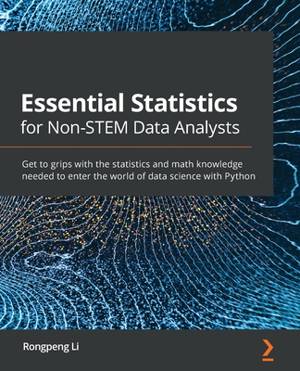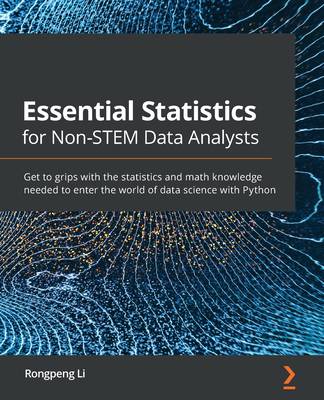
- Retrait gratuit dans votre magasin Club
- 7.000.000 titres dans notre catalogue
- Payer en toute sécurité
- Toujours un magasin près de chez vous
- Retrait gratuit dans votre magasin Club
- 7.000.0000 titres dans notre catalogue
- Payer en toute sécurité
- Toujours un magasin près de chez vous
Essential Statistics for Non-STEM Data Analysts
Get to grips with the statistics and math knowledge needed to enter the world of data science with Python
Rongpeng LiDescription
Reinforce your understanding of data science and data analysis from a statistical perspective to extract meaningful insights from your data using Python programming
Key features
- Work your way through the entire data analysis pipeline with statistics concerns in mind to make reasonable decisions
- Understand how various data science algorithms function
- Build a solid foundation in statistics for data science and machine learning using Python-based examples
Book Description
Statistics remain the backbone of modern analysis tasks, helping you to interpret the results produced by data science pipelines. This book is a detailed guide covering the math and various statistical methods required for undertaking data science tasks.
The book starts by showing you how to preprocess data and inspect distributions and correlations from a statistical perspective. You'll then get to grips with the fundamentals of statistical analysis and apply its concepts to real-world datasets. As you advance, you'll find out how statistical concepts emerge from different stages of data science pipelines, understand the summary of datasets in the language of statistics, and use it to build a solid foundation for robust data products such as explanatory models and predictive models. Once you've uncovered the working mechanism of data science algorithms, you'll cover essential concepts for efficient data collection, cleaning, mining, visualization, and analysis. Finally, you'll implement statistical methods in key machine learning tasks such as classification, regression, tree-based methods, and ensemble learning.
By the end of this Essential Statistics for Non-STEM Data Analysts book, you'll have learned how to build and present a self-contained, statistics-backed data product to meet your business goals.
What you will learn
- Find out how to grab and load data into an analysis environment
- Perform descriptive analysis to extract meaningful summaries from data
- Discover probability, parameter estimation, hypothesis tests, and experiment design best practices
- Get to grips with resampling and bootstrapping in Python
- Delve into statistical tests with variance analysis, time series analysis, and A/B test examples
- Understand the statistics behind popular machine learning algorithms
- Answer questions on statistics for data scientist interviews
Who this book is for
This book is an entry-level guide for data science enthusiasts, data analysts, and anyone starting out in the field of data science and looking to learn the essential statistical concepts with the help of simple explanations and examples. If you're a developer or student with a non-mathematical background, you'll find this book useful. Working knowledge of the Python programming language is required.
Spécifications
Parties prenantes
- Auteur(s) :
- Editeur:
Contenu
- Nombre de pages :
- 394
- Langue:
- Anglais
Caractéristiques
- EAN:
- 9781838984847
- Date de parution :
- 13-11-20
- Format:
- Livre broché
- Format numérique:
- Trade paperback (VS)
- Dimensions :
- 190 mm x 235 mm
- Poids :
- 675 g

Les avis
Nous publions uniquement les avis qui respectent les conditions requises. Consultez nos conditions pour les avis.






